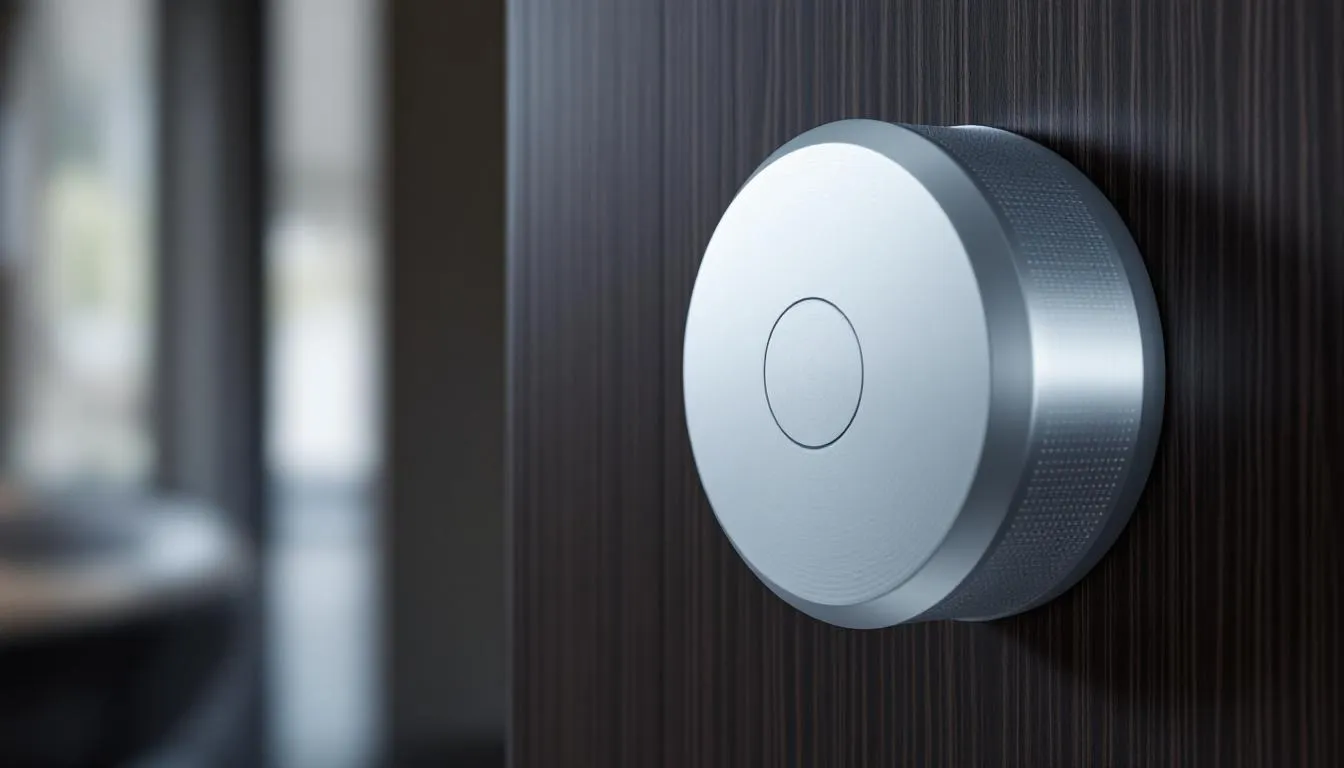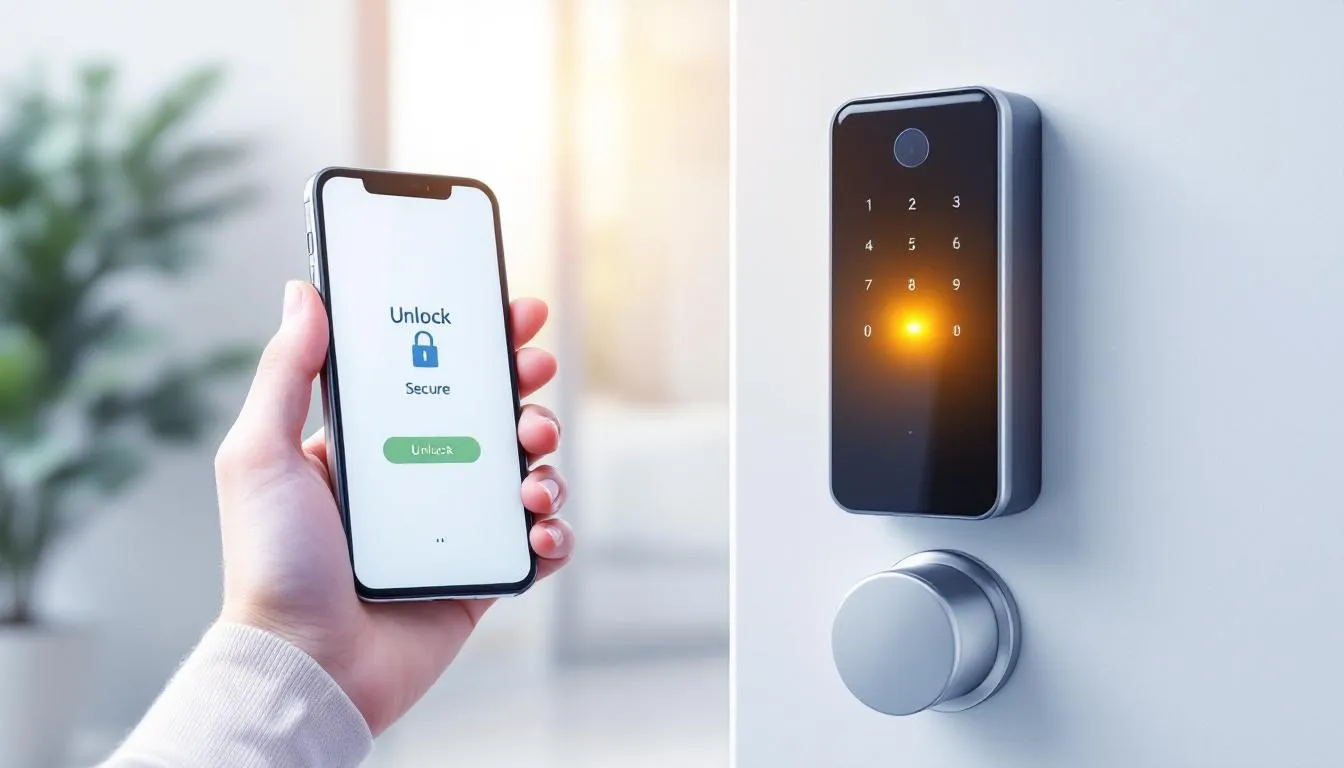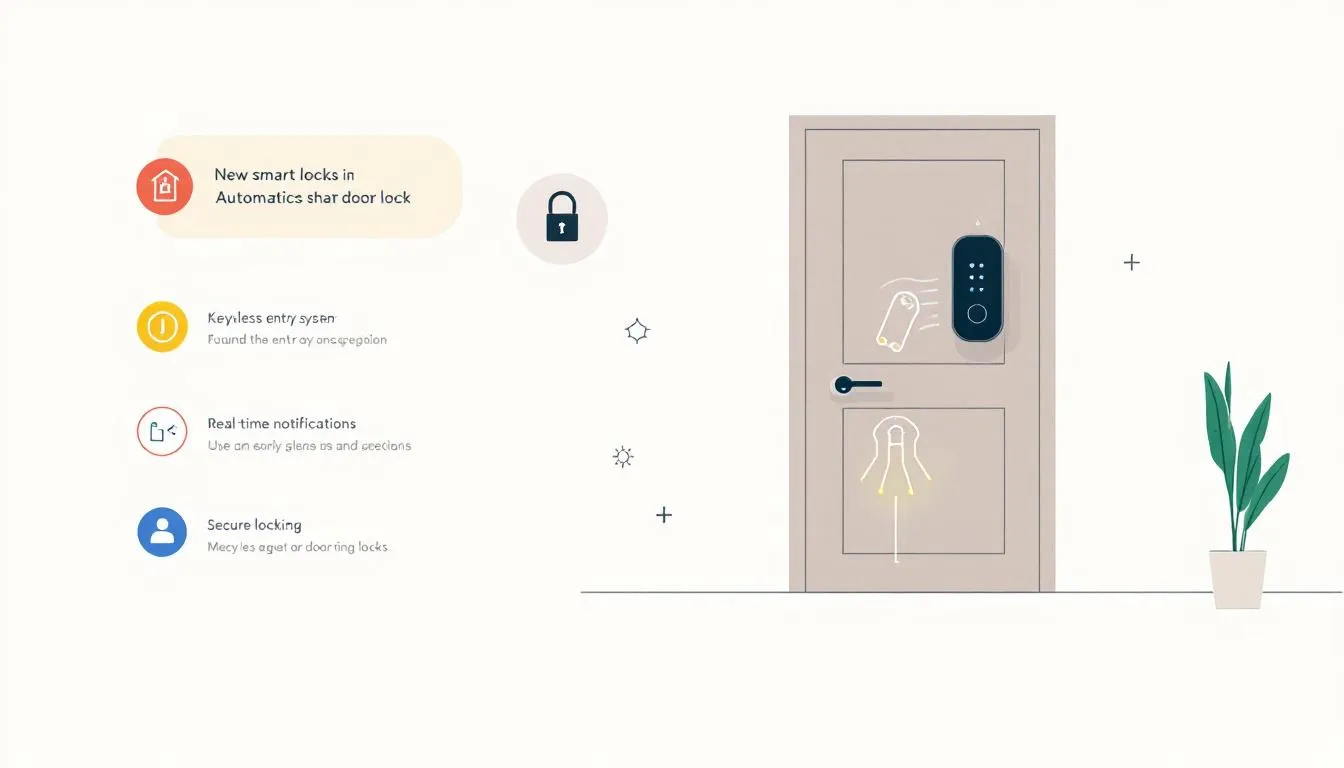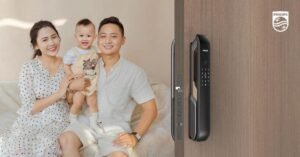Are smart door locks safer than keyed entry? Yes, it’s. In this article, we examine whether smart door locks are indeed safer than keyed entry by looking at the security features of both to help you decide which option is best for your home. The question of whether smart door locks is smart door locks safer than keyed entry is crucial for homeowners considering an upgrade.
Key Takeaways
- Smart locks provide enhanced security features such as keyless entry, real-time alerts, and customizable access codes, making them a safer option than traditional keyed locks.
- Remote access capabilities allow homeowners to manage their door locks from anywhere, improving convenience and security monitoring.
- While smart locks present advanced functionalities, they also pose cybersecurity risks and potential mechanical failures; thus, regular maintenance and secure settings are crucial.
Keyless Entry: The End of Physical Keys

Smart door locks eliminate the need for physical keys entirely. Imagine approaching your front door and using:
- a PIN code
- fingerprint
- smartphone app to gain entry.
This keyless entry method significantly reduces unauthorized access risks since there are no physical keys to lose or duplicate. The convenience of never having to carry or search for keys is invaluable, especially in today’s fast-paced world. An electronic door lock enhances this experience further, and with the use of pin codes, security is further strengthened. Electronic door locks provide an additional layer of protection for your home.
Smart locks also offer advanced security features to safeguard against unauthorized access. Many come equipped with encryption and authentication technologies, ensuring that only approved users can unlock the door. These measures provide an extra layer of protection, making smart locks a safer option compared to traditional locks that rely solely on physical keys.
Remote Access Control: Convenience and Security

A standout benefit of smart locks is the ability to manage access remotely. Whether you’re at work, on vacation, or simply away from home, you can lock or unlock your doors using your smartphone. This feature provides homeowners with unprecedented control over their home’s security, ensuring that doors are always securely locked when needed.
Remote access isn’t just about convenience; it also enhances security. Homeowners can monitor entry activities and manage access codes through dedicated apps, receiving real-time notifications about door status and access attempts. This awareness is crucial for maintaining home security, allowing immediate action if something seems amiss.
For property managers, granting or denying access remotely minimizes the need for physical key exchanges, leading to cost savings and improved security, providing them with more control.
Customized Access Codes for Enhanced Security
Smart locks offer several key features for enhanced security management:
- Allow the creation and management of unique access codes for different users.
- Enable property owners to generate up to 50 unique codes.
- Provide precise tracking of who accessed the home and when.
- Eliminate the need for rekeying.
These features are particularly useful for families, businesses, and property managers who need to track multiple users.
Smart locks offer several security features:
- Real-time alerts for access attempts
- Detailed access logs
- Temporary access codes for guests or service providers that expire automatically after use, minimizing the risk of unauthorized access
Integration with biometric scanners and RFID cards offers added security options, ensuring that only authorized individuals can gain entry.
Real-Time Alerts and Monitoring
One of the critical advantages of smart locks is their ability to provide real-time alerts and monitoring. Homeowners can receive immediate notifications about door activity, including tamper alerts and intrusion notifications, improving their overall security awareness.
These real time monitoring alerts allow for quick detection and response to unauthorized access, ensuring that homeowners are always informed about the status of their security systems.
Voice Command and Hands-Free Control
Integrating smart locks with voice command systems like Amazon Alexa and Google Assistant takes convenience to the next level. Users can lock or unlock their doors with simple voice commands, eliminating the need for physical interaction. This hands-free control is particularly beneficial for those who often have their hands full or individuals with mobility issues.
Using a Wi-Fi or Bluetooth-enabled connected device, homeowners can easily manage their locks through voice assistants and other devices, further integrating their smart home systems into their wi fi network. Imagine telling your smart assistant to lock the front door while you’re cooking or asking it to unlock the door when a dog walker arrives.
This seamless integration not only enhances convenience but also adds an extra layer of modern luxury to home security.
Automatic Locking Features

Many smart locks have automatic locking features to prevent doors from being left unlocked. These locks can engage automatically as soon as the door is closed, providing peace of mind that your home is secure even if you forget to lock up. Users can customize how long their door remains unlocked before it can automatically lock, with options ranging from 30 seconds to 30 minutes.
Moreover, some smart locks offer hands-free unlocking capabilities, detecting your presence via smartphone location and unlocking the smart door lock as you approach. Not all smart locks have this feature, which is particularly useful when your hands are full, enhancing both convenience and security through smartphone apps.
Such advanced features make smart locks safer not only a modern convenience but also a more secure option compared to traditional locks. Additionally, smart locks safe provide enhanced protection for your home.
Two-Factor Authentication for Extra Security
To further bolster security, many smart locks offer added protection through two-factor authentication (2FA) and an access code. This system requires two forms of verification, such as a password and a code sent to your smartphone, significantly reducing unauthorized access risks.
Implementing 2FA ensures an extra layer of security, making it much harder for intruders to gain entry, even if they compromise one form of authentication.
Integration with Smart Home Systems
Smart locks integrate seamlessly with other smart home systems, enhancing overall home automation. Users can create automated routines that lock or unlock doors at specific times, ensuring their home is secure based on their schedule. For instance, a smart lock can be programmed to lock the door automatically when you arm your home security system before going to bed.
Smart locks can interact with other smart devices, such as security cameras and lighting systems. When the door is unlocked, exterior lights can be triggered to turn on and security cameras can start recording, providing a comprehensive security solution.
This level of integration offers unparalleled convenience and enhanced security, making smart locks a valuable addition to any smart home.
Potential Cybersecurity Threats
Despite their many benefits, smart locks have vulnerabilities. Their reliance on wireless connections makes them susceptible to hacking attempts and connectivity issues. Hackers can exploit weak Wi-Fi networks to gain unauthorized access to smart locks, posing significant security concerns. To mitigate these risks, homeowners should secure their Wi-Fi networks, use strong passwords, and ensure their smart locks are regularly updated with the latest firmware.
Implementing two-factor authentication provides a robust defense against cyber threats. Requiring multiple forms of verification significantly reduces unauthorized access risks due to phishing attempts or account takeovers.
Users must remain vigilant and adopt best practices to maintain the security of their smart locks.
Power and Connectivity Concerns
Smart locks rely on batteries or electric power, meaning they can lose functionality during power outages, posing potential security risks. However, many are equipped with backup access options like manual key overrides and biometric scans to prevent lockouts during such failures.
Bluetooth-enabled smart locks can operate offline, ensuring access even without a Wi-Fi connection. Homeowners should regularly check their lock’s battery status and ensure backup options are functional to maintain security.
Mechanical Failures and Backup Options
While mechanical failures in smart locks are rare, alignment issues—such as a misaligned strike plate—can still compromise bolt engagement. From a manufacturing standpoint, this highlights the importance of precise installation and robust hardware design. Premium materials like solid bronze or zinc alloy not only reduce wear but also extend product lifespan, minimizing warranty claims and service costs for distributors.
To mitigate electronic risks (e.g., dead batteries or motor failure), most factory-grade smart locks are engineered with redundant access options, including manual key overrides and external charging ports. These backup systems provide dealers with reassurance when marketing to commercial clients or hospitality partners, where lockouts can impact operations and reputation. Offering smart locks with multi-tier fail-safes is a key differentiator in B2B sales—ensuring both uptime and user trust across all environments.
Are Smart Locks Better Than Traditional Locks?

From a B2B standpoint, smart locks deliver a measurable security and operational advantage over traditional mechanical locks. Features like remote access control, real-time tamper alerts, audit trails, and integration with broader security ecosystems (such as alarm panels or property management platforms) provide enhanced visibility and risk mitigation—key selling points for commercial buildings, rental properties, and high-traffic facilities.
In contrast, traditional locks, while cost-effective and easy to install, lack data-driven functionality and are more prone to physical bypass methods such as picking or bumping. They also require ongoing key management—an operational burden for multifamily units, hotels, or short-term rentals.
That said, not all smart locks are created equal. Factory-level improvements—such as AES encryption, S2 Z-Wave security, and biometric safeguards—should be prioritized to address concerns over connectivity vulnerabilities or cyber threats. For B2B customers, the combination of remote management, fail-safe mechanical overrides, and upgrade-ready firmware positions smart locks as the preferred long-term investment over legacy keyed systems.
Summary
For dealers, property managers, and commercial buyers, smart locks represent more than just a security upgrade—they are a value-added solution that delivers operational efficiency, tenant satisfaction, and scalable access control. Unlike traditional keyed systems, smart locks reduce key management costs, enable remote credentialing, and integrate seamlessly with property automation platforms.
With features like audit trails, time-sensitive codes, and dual authentication, smart locks offer enhanced security that aligns with today’s digital-first property management standards. While cybersecurity and power concerns remain considerations, choosing smart locks with encrypted protocols, OTA firmware updates, and mechanical overrides can effectively mitigate these risks.
Smart locks are no longer just a consumer convenience—they are a commercially viable, future-ready investment. Dealers and businesses that adopt and promote this technology today will lead the market tomorrow.
Frequently Asked Questions
How do smart locks enhance security compared to traditional locks?
Smart locks significantly enhance security over traditional locks by providing features such as keyless entry, remote access control, real-time alerts, and two-factor authentication. These advancements reduce the risk of unauthorized access and improve overall safety.
Can smart locks be hacked?
Yes, smart locks can be hacked, but implementing strong passwords, securing Wi-Fi networks, and using two-factor authentication can greatly mitigate this risk.
What happens if the power goes out or the battery dies in a smart lock?
If the power goes out or the battery dies in a smart lock, you can typically use a manual key override or an external charging port to regain access. Therefore, it’s advisable to familiarize yourself with these backup options to ensure security and accessibility.
Are smart locks easy to install?
Smart locks are generally easy to install, with many models designed for straightforward setup using basic tools and clear instructions. Therefore, you can likely upgrade your home’s security without significant hassle.
Do smart locks work with existing smart home systems?
Smart locks often integrate seamlessly with existing smart home systems, enabling automated routines and interaction with other devices such as security cameras and lighting. This compatibility enhances your home security and convenience.




